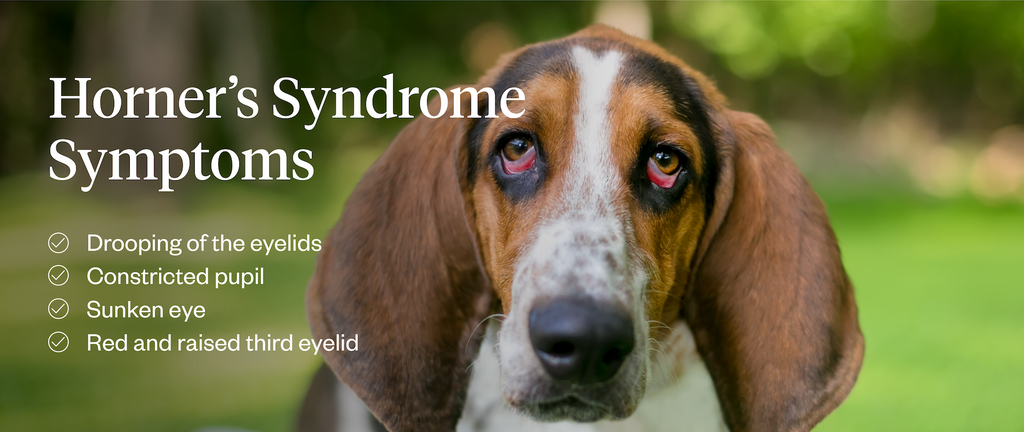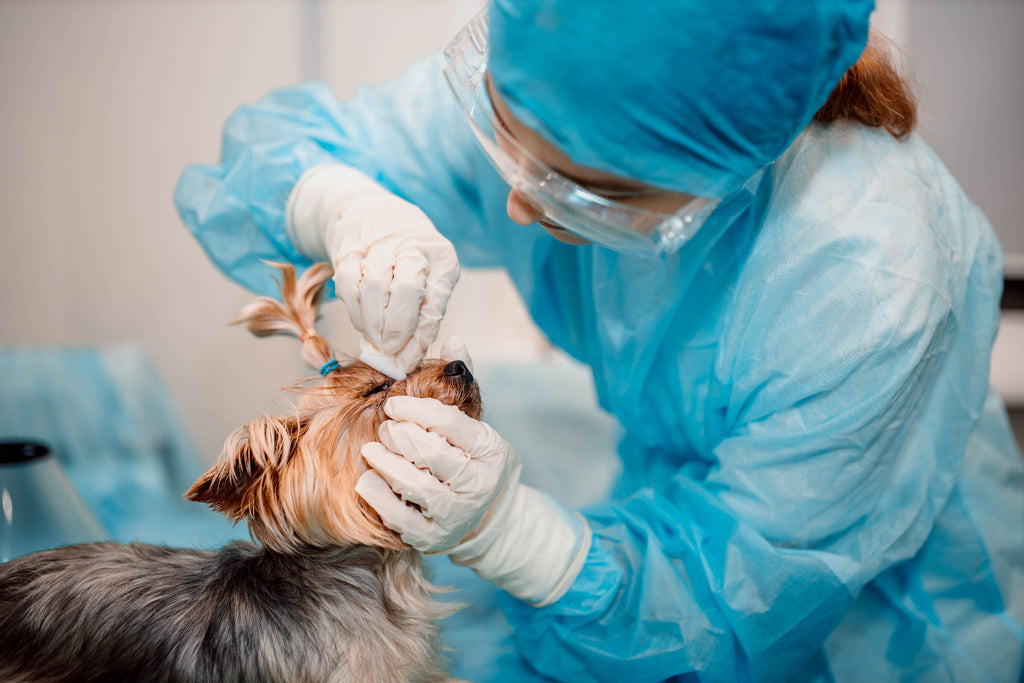9 Min Read
Horner's Syndrome In Dogs: Everything You Need To Know
Key takeaway

Why pet owners are switching to online vet care with Dutch
-
Prescriptions delivered free to you
-
Fast access to Licensed Vets over video
-
Unlimited video visits and follow-ups
As a pet parent, you're attuned to your pet's unique features and behaviors. However, when unusual symptoms appear, like a swollen eye or conjunctivitis, it can be concerning. One condition that can affect dogs is Horner's syndrome. While this condition may sound complicated, it's crucial to understand Horner's syndrome to recognize potential causes, its impact on your pet, and the steps to take for diagnosis and treatment.
Horner's syndrome manifests in a combination of physical changes in your pet's eye. These symptoms can signify an underlying health issue, though Horner's syndrome in dogs itself is not life-threatening.
So, what is Horner's syndrome in dogs? Keep reading to learn more about this condition and how to best help your pet.
- What Is Horner's Syndrome In Dogs?
- Symptoms Of Horner's Syndrome In Dogs
- Canine Horner's Syndrome Causes
- Horner's Syndrome In Dogs Diagnosis
- Horner's Syndrome In Dogs Treatment
- Preventing Horner's In Dogs
- Horner's Syndrome In Dogs: FAQs
- Final Notes
What Is Horner's Syndrome In Dogs?
Horner's syndrome in dogs is a neurological disorder that results from a dysfunction in the sympathetic nerve pathway, a part of the nervous system that controls involuntary bodily functions.1 Most commonly, it affects one side of the head, primarily the eye area, but it can be bilateral in rare cases.1 In many cases, the exact cause of Horner's syndrome is unknown.
This condition itself is not painful for the dog. However, determining and addressing the underlying cause is essential for their overall health and comfort.
Symptoms Of Horner's Syndrome In Dogs

When a dog has Horner's syndrome, the signs are primarily localized to the eye and surrounding facial area of the affected side. These include:
- Ptosis: Drooping of the eyelids.
- Miosis: Constricted or small pupil.
- Enophthalmos: Sunken eye appearance.2
The most notable symptom is a change in the appearance of the eye. Pet parents might notice a drooping of the upper eyelid, giving the impression of drowsiness even when the dog is fully awake. Dogs may also have a smaller pupil appearance in one eye.2
Another common symptom is the affected eye appearing sunken into the socket. This can sometimes give the illusion that one eye is smaller than the other. Additionally, the third eyelid, usually a semi-hidden membrane in the inner corner of the eye, can become more prominent.2
While these changes in your dog's eye are dramatic, pet parents should be aware that Horner's syndrome isn't painful for the dog and doesn't affect their vision. However, the underlying cause can lead to discomfort, making it essential to consult a veterinarian.
Canine Horner's Syndrome Causes

Horner's syndrome in dogs arises due to a disruption in the sympathetic nerve pathway, which plays a crucial role in the nervous system. Several potential causes can lead to this disruption, including trauma, tumors, and ear infections.
Physical injury, especially to the head, can result in damage to the sympathetic nerve pathway. Accidents, fights with other animals, or any other traumatic incidents can lead to Horner's syndrome. Additionally, problems in the ear, like middle or inner ear infections, can cause significant inflammation, which can affect the nervous system.
In many cases, Horner's syndrome is idiopathic, meaning the underlying cause is unknown. Despite thorough examinations and tests, vets might not be able to pinpoint a specific reason.
Horner's syndrome can affect any dog, but golden retrievers tend to experience it more frequently.1

Horner's Syndrome In Dogs Diagnosis
Diagnosing Horner's syndrome in dogs involves a combination of clinical observation and diagnostic tests, which may include ascertaining its underlying cause.
The initial step involves a physical and neurological exam. The vet will evaluate your dog's eye and facial symptoms, looking for the telltale signs of Horner's syndrome. Then, they'll review your dog's medical history, which may be able to provide insights into the underlying cause. Details about recent trauma, infections, and surgeries can be informative.
The vet will also perform diagnostic testing by starting with bloodwork.1 Your pet's bloodwork can provide an overview of their general health, which can indicate issues or other conditions related to the observed symptoms.
Vets also use a 4DX test to check for major diseases.1 While this test isn't directly related to Horner's syndrome, it can help rule out other potential underlying causes of your dog's symptoms.
Given that ear infections and other ear-related issues can be a cause of Horner's syndrome, your vet will perform an otoscopic (ear) exam. During this proctor, they'll use an otoscope to inspect the ear canal and eardrum to identify any infections or abnormalities in the ear.
Radiographs, also known as X-rays, are also used to provide visuals of the internal structures of the body.1 Images will be taken from three different angles to look for any abnormalities like growths that may affect the nerve pathway and lead to Horner's syndrome.
Horner's Syndrome In Dogs Treatment
Horner's syndrome in dogs treatment largely depends on its underlying cause. Again, Horner's syndrome isn't typically painful and likely won't cause issues in your dog's vision. However, addressing the root cause can often alleviate the symptoms while preventing potential complications.
The first step in treating Horner's syndrome in dogs is addressing the cause. For instance, if ear infections are the cause, your vet might prescribe antibiotics or antifungal medications in conjunction with ear cleaners or topical treatments. By eliminating inflammation disrupting the nerve pathways, your dog's symptoms might improve.
Unfortunately, if your dog's Horner's syndrome is idiopathic, there's no underlying cause to treat. However, some cases resolve on their own, depending on the severity.3 Keep in mind that your dog isn't in pain or experiencing vision problems during this time, so even if your vet chooses a wait-and-see approach to treating your dog, they're not suffering or at a disadvantage.
Phenylephrine drops are also commonly used to temporarily improve the appearance of the dog's eye.3 However, this isn't a cure and, in most cases, is unnecessary because your dog isn't experiencing any pain.
Whether the cause is identified or not, regular veterinary check-ups are crucial. These allow the vet to monitor the progression or resolution of Horner's syndrome and make any necessary adjustments to the treatment plan. During this period, you can support your dog by ensuring a stress-free environment, offering a balanced diet, and avoiding potential risk factors like trauma.
Engaging in exercise and providing mental stimulation, like usual, can also be beneficial.
In complex cases, or if there's suspicion of a growth or tumor, your primary vet might refer you to a veterinary neurologist or ophthalmologist for specialized care. Remember, treating the underlying cause can reduce the symptoms associated with Horner's syndrome, so your dog will likely need surgery if they have a growth in their ear.
Preventing Horner's In Dogs
While there's no foolproof method to prevent Horner's syndrome in dogs, pet parents can adopt proactive measures to minimize the risks and ensure their dogs remain in optimal health.
Remember, one of the most common ways dogs can develop conditions like Horner's syndrome is through trauma. Ensure your home environment is safe, and supervise your pet during outdoor activities. If your dog is particularly active, take extra precautions to minimize the risk of injuries.
Regular vet visits can also help detect issues that might lead to Horner's syndrome early, such as ear infections and growth. These check-ups provide an opportunity for vets to examine and treat potential problems before they escalate. Additionally, make sure you prevent tear stains, which can be an early sign of irritation or infections.
While any dog can get Horner's syndrome, some breeds might have a predisposition to certain conditions. Being well-informed about your dog's breed-specific health risks and taking preventive measures can be beneficial.
And, as always, at the first sign of any health issue, whether it's an ear infection, unusual growth, or sign of distress, seek veterinary advice. Prompt intervention can often prevent complications and the onset of conditions like Horner's syndrome.
Horner's Syndrome In Dogs: FAQs
Is Horner's syndrome life threatening in dogs?
Horner's syndrome isn't life-threatening in dogs. The condition primarily affects the sympathetic nerve pathway, leading to ocular and facial symptoms. However, while these manifestations might be disconcerting to pet parents, they don't pose a direct threat to your dog's life.
That said, it's crucial to differentiate between Horner's syndrome and potential underlying causes. The appearance of Horner's syndrome can be triggered by trauma, tumors, infections, and other underlying health issues. Some of these causes might have more severe health implications. For instance, a tumor pressing on the nerve pathway could require immediate medical attention.
Therefore, while Horner's syndrome isn't inherently dangerous, it may be a sign of something serious, which is why it's so crucial to consult a vet as soon as you notice symptoms.
Does Horner's syndrome cause blindness in dogs?
Unlike other dog eye issues like cherry eye, Horner's syndrome doesn't typically cause vision problems or blindness in dogs. While the symptoms can be alarming and might alter the affected eye's appearance, they don't compromise the dog's ability to see clearly. Instead, this syndrome primarily affects the nerve pathway responsible for certain eye and facial functions. The condition doesn't damage the retina, optic nerve, or other critical structures involved in vision.
Is Horner's syndrome painful?
Horner's syndrome isn't painful for your dog. When a dog exhibits the signs of Horner's syndrome, such as a drooping eyelid, constricted pupil, sunken appearance or the eyeball, or prominence of the third eyelid, these are primarily neurological symptoms and don't indicate that your dog is in pain.
Still, it's vital to determine what might be causing Horner's syndrome in the first place. The root causes might lead to discomfort or pain. For instance, an ear infection can be extremely painful and itchy for dogs.
So, even if the symptoms of Horner's syndrome aren't painful, pet parents should remain vigilant. If your dog shows any behavioral changes like reduced activity levels or sensitivity to touch, they might indicate pain or discomfort from an underlying issue.

Final Notes
While Horner's syndrome doesn't cause pain or affect your dog's quality of life, it's important to be informed and prepared to handle anything as a pet parent. While Horner's syndrome isn't life-threatening, it can indicate a serious underlying issue that requires attention. A comprehensive approach to diagnosis, treatment, and prevention will ensure the best outcome for your dog.
Checking in with your vet and monitoring your dog for behavioral and physical changes can help you detect issues early before they become more severe. For moments of uncertainty, when you notice something is off but aren't sure if a vet visit is necessary, Dutch can be a valuable resource.
With Dutch, you can access veterinary expertise from the comfort of your home, getting immediate advice, guidance, and treatments to ensure your pet gets timely care while giving you peace of mind. Additionally, if you need medications or treatments for your dog, you can get them from our online pharmacy and have them delivered right to your doorstep. Try Dutch today.Share
References
-
"Horner's Syndrome." Veterinary Teaching Hospital, https://vetmedbiosci.colostate.edu/vth/services/ophthalmology/horners-syndrome/.
-
Zwueste, Danielle M, and Bruce H Grahn. "A Review of Horner's Syndrome in Small Animals." The Canadian Veterinary Journal, U.S. National Library of Medicine, Jan. 2019, www.ncbi.nlm.nih.gov/pmc/articles/PMC6294019/.
-
Wendy, Brooks. "Horner's Syndrome in Cats and Dogs." VIN, https://veterinarypartner.vin.com/default.aspx?pid=19239&id=4951369.

